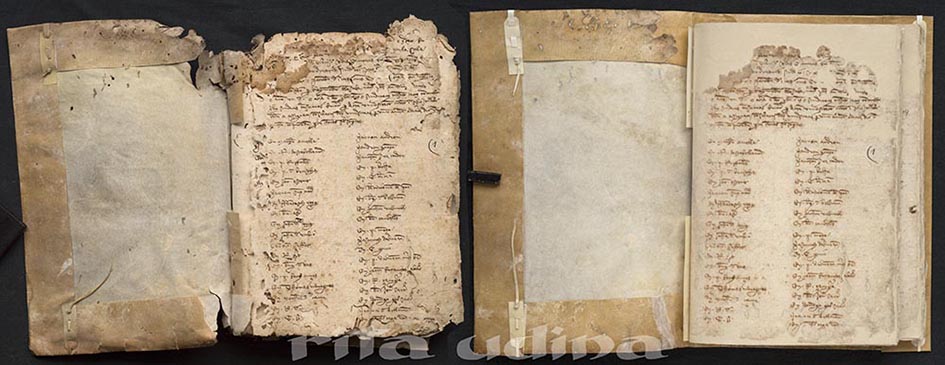Conservation of medieval manuscripts on rag paper with rolled sewing
- Owner: Regional Archive of Baix Ebre (Tortosa, Tarragona, Spain). Catalonia Government.
- Artefact: Two medieval manuscripts on rag paper and limp vellum binding. The sewing thread is made of rolled parchment, sewn with independent knots onto inner parchment stays. One of them onto outer leather tackets as well (see video below, although there is almost no trace of the leather support).
- Date: Dated 1356 and 1369.
- Damages: Paper and parchment is seriously woodworm eaten. Covers are wrinkled, sewing is partially broken and folios have tide lines and mould stains.
- Conservation treatment: Disbinding, dry cleaning. Reporting collation and fragments of papers. Wet cleaning and leaf-casting the folios with paper pulp. The parchment covers were reinforces with toned japanese tissue, The restored bindings sewn back on the textblock, reproducing the original rolled sewing on parchment, with leather tackets.
- Conservators: Maria Correa, Se Hee Song, Rita Udina.
- Other links: Facebook album and Instagram. Read the POST of this project if you want to see two medieval angels jumping happy as Larry. The discussion whether sometimes the binding is restored, and others reproduced, has these manuscripts as an example in the lecture about conservation of reused bindings (minutes 5:20 – 7:40″, at the end of this post). In the interview with IBookbinding ethical issues of this conservation is discussed (below).




Clients
AHEH (10)
Alcon-Cusi Pharmacy Museum (5)
Archive Barcelona Sants-Montjuïc Dst. (5)
Archives (51)
Ayuntamiento Barcelona (5)
Barcelona City Council (11)
Barcelona Municipal Archive (9)
Buat Fine Art (3)
CoAC (Association of Architects of Catalonia) (15)
Cores (5)
Documentation Center of Catalan Orfeó (3)
Domènech i Montaner (5)
Gaboche Ars (3)
Galleries (24)
Gazi Husrev-Begova Biblioteka (3)
Government of Catalonia (19)
Historical Archive of Barcelona (3)
Historical Archive of Lleida (4)
ICON (4)
Industrial Museum of Ter (4)
Institute for Cultural Heritage of Spain (IPCE) (6)
INTACH (Dehli) (7)
La Pedrera Foundation (4)
Libraries (30)
Municipal Archive of Renteria (5)
Museums (26)
Márk Somogyi (3)
National Archive of Catalonia (ANC) (8)
National Museum of Norway (4)
NSK - National Library and University (Zagreb CROATIA) (5)
onLine (14)
private collector (27)
Provincial Council of Barcelona (DiBa) (5)
Public Library of Girona Carles Rahola (7)
Regional Archive Baix Ebre (3)
Regional Archive of Vallès Occidental (4)
Regional Archive Urgell (4)
Research Library of Dubrovnik (CROATIA) (4)
Restauratoren Nederland (5)
Rijksmuseum (5)
Sant Cugat del Vallès Council (5)
SICP Chile (3)
Sitges Museums (4)
Tapestry Art Centre Grau Garriga (5)
University of Granada (Spain) (4)
Types of projects
Conservation of medieval manuscripts on rag paper with rolled sewing
- Owner: Regional Archive of Baix Ebre (Tortosa, Tarragona, Spain). Catalonia Government.
- Artefact: Two medieval manuscripts on rag paper and limp vellum binding. The sewing thread is made of rolled parchment, sewn with independent knots onto inner parchment stays. One of them onto outer leather tackets as well (see video below, although there is almost no trace of the leather support).
- Date: Dated 1356 and 1369.
- Damages: Paper and parchment is seriously woodworm eaten. Covers are wrinkled, sewing is partially broken and folios have tide lines and mould stains.
- Conservation treatment: Disbinding, dry cleaning. Reporting collation and fragments of papers. Wet cleaning and leaf-casting the folios with paper pulp. The parchment covers were reinforces with toned japanese tissue, The restored bindings sewn back on the textblock, reproducing the original rolled sewing on parchment, with leather tackets.
- Conservators: Maria Correa, Se Hee Song, Rita Udina.
- Other links: Facebook album and Instagram. Read the POST of this project if you want to see two medieval angels jumping happy as Larry. The discussion whether sometimes the binding is restored, and others reproduced, has these manuscripts as an example in the lecture about conservation of reused bindings (minutes 5:20 – 7:40″, at the end of this post). In the interview with IBookbinding ethical issues of this conservation is discussed (below).




Clients
AHEH (10)
Alcon-Cusi Pharmacy Museum (5)
Archive Barcelona Sants-Montjuïc Dst. (5)
Archives (51)
Ayuntamiento Barcelona (5)
Barcelona City Council (11)
Barcelona Municipal Archive (9)
Buat Fine Art (3)
CoAC (Association of Architects of Catalonia) (15)
Cores (5)
Documentation Center of Catalan Orfeó (3)
Domènech i Montaner (5)
Gaboche Ars (3)
Galleries (24)
Gazi Husrev-Begova Biblioteka (3)
Government of Catalonia (19)
Historical Archive of Barcelona (3)
Historical Archive of Lleida (4)
ICON (4)
Industrial Museum of Ter (4)
Institute for Cultural Heritage of Spain (IPCE) (6)
INTACH (Dehli) (7)
La Pedrera Foundation (4)
Libraries (30)
Municipal Archive of Renteria (5)
Museums (26)
Márk Somogyi (3)
National Archive of Catalonia (ANC) (8)
National Museum of Norway (4)
NSK - National Library and University (Zagreb CROATIA) (5)
onLine (14)
private collector (27)
Provincial Council of Barcelona (DiBa) (5)
Public Library of Girona Carles Rahola (7)
Regional Archive Baix Ebre (3)
Regional Archive of Vallès Occidental (4)
Regional Archive Urgell (4)
Research Library of Dubrovnik (CROATIA) (4)
Restauratoren Nederland (5)
Rijksmuseum (5)
Sant Cugat del Vallès Council (5)
SICP Chile (3)
Sitges Museums (4)
Tapestry Art Centre Grau Garriga (5)
University of Granada (Spain) (4)

